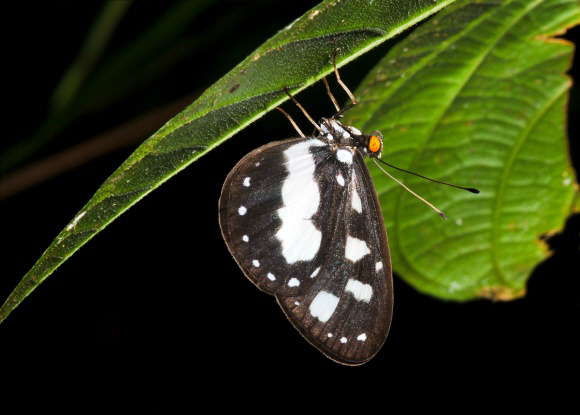
Introduction
The Tellervini was originally thought to comprise of a single Australasian species Tellervo zoilus, of which 9 subspecies were recognised. Recent phylogenetic research however has led to all of these being elevated to full species status. The butterflies are allied to the Danaini and Ithomiini, but differ morphologically from both in several respects. They are found variously in Queensland, West Irian, Papua New Guinea and the Solomon Islands.
The butterflies are easily recognised by their conspicuous black and white markings, long straight antennae and large orange or yellow eyes.
Tellervo assarica is endemic to West Irian, where it is found on the mainland and on the islands of Seram, Amboina and Yapen.
Habitats
This species inhabits rainforest at elevations between sea level and about 500m.
Lifecycle
I do not have any data regarding assarica. The following applies to the Australian species zoilus:
The eggs are white and are laid singly on leaves of the foodplant. The larva is dark grey with four thin white broken transverse bands on each segment. It has a pair of raised yellow spots on the anal segment, and a pair of yellow-based black thorn-like filaments projecting from the thorax. The larval foodplant is Parsonia, a noxious woody vine in the family Apocynaceae. It is assumed that the larvae sequester toxins from these plants and that the larvae, pupae and adult butterflies are unpalatable to birds and other small vertebrates.
The larvae exhibit territorial behaviour, marking each leaf with a regurgitated fluid before beginning to feed. This fluid is probably a deterrent to ants and other predatory insects. If molested the larva wriggles violently from side to side, thrusting at the intruder with its thorn-like thoracic filaments.
The pupa is pale shiny green with black spots. It is suspended by the cremaster from the underside of a leaf.
Adult behaviour
Both sexes nectar at Lantana and various herbaceous flowering plants. Males sit on leaves slowly fanning their wings to release pheromones and attract females. the butterflies commonly rest under leaves.
